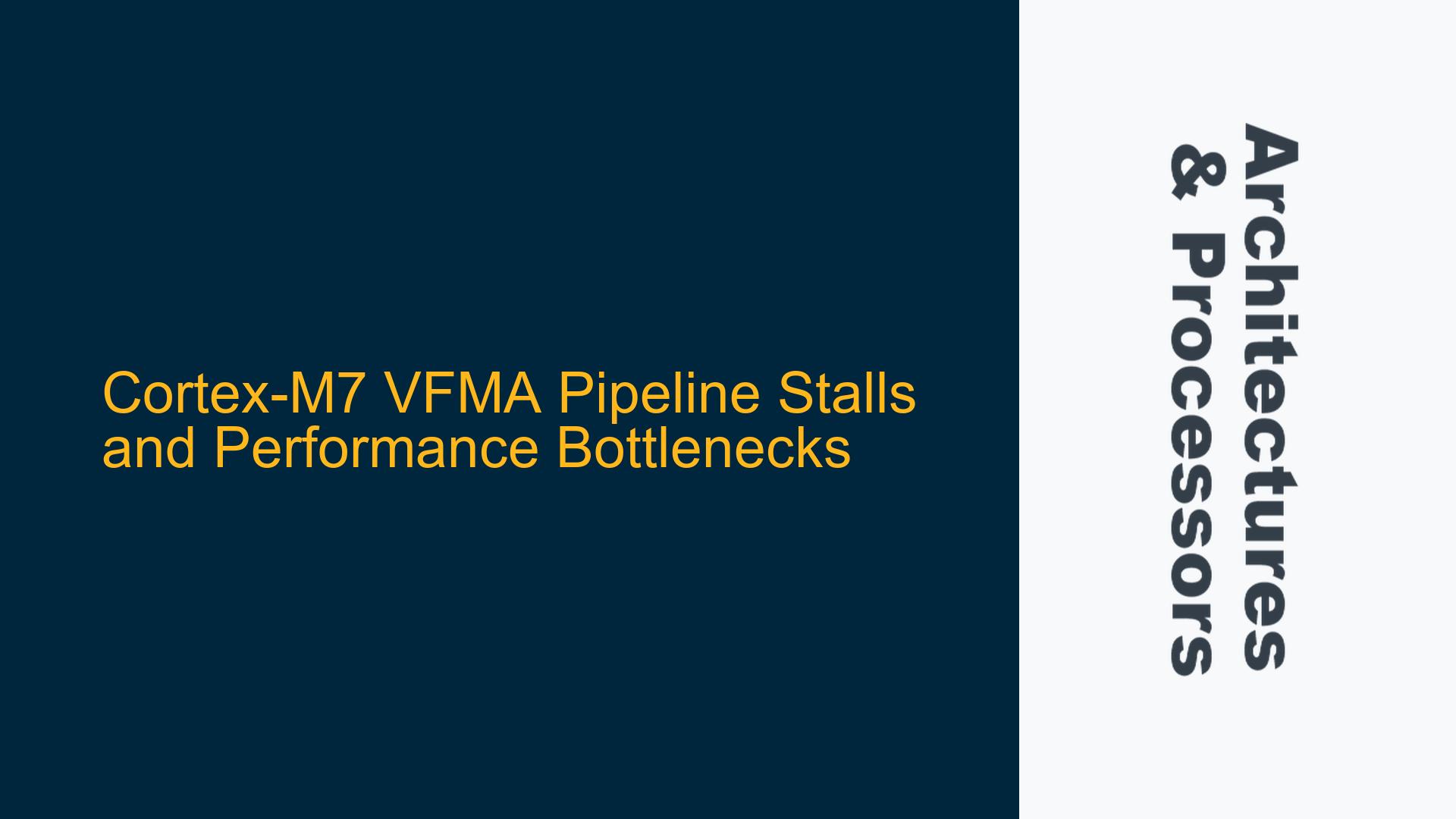Cortex-M7 VFMA Instruction Pipeline Behavior and Performance Degradation
The Cortex-M7’s VFMA (Vector Fused Multiply-Add) instruction is a powerful floating-point operation that combines multiplication and addition in a single cycle, theoretically improving performance for computationally intensive tasks such as polynomial evaluation. However, the observed behavior in the provided benchmarks reveals significant pipeline stalls and performance degradation when VFMA is interleaved with other floating-point or load/store instructions. This behavior is counterintuitive, as one would expect the Cortex-M7’s dual-issue pipeline to handle such instructions efficiently. The root cause lies in the microarchitectural implementation of the VFMA instruction and its interaction with the pipeline, memory subsystem, and register dependencies.
The Cortex-M7’s pipeline is designed to execute two instructions per cycle under optimal conditions, but this parallelism is highly dependent on the types of instructions being executed and their dependencies. The VFMA instruction, due to its complexity, occupies multiple pipeline stages and can cause stalls when interleaved with other instructions. This is particularly evident when VFMA is paired with VMOV or VLDR instructions, where the pipeline throughput drops to 0.5 instructions per cycle, indicating severe stalls. Additionally, the interaction between VFMA and VADD instructions results in an unexpected 2.5 cycles per instruction, further highlighting the inefficiencies in the pipeline scheduling.
Microarchitectural Constraints and Instruction Scheduling
The Cortex-M7’s pipeline consists of several stages, including fetch, decode, execute, and writeback. The execute stage is further divided into multiple sub-stages for floating-point operations, which are handled by the FPU (Floating-Point Unit). The VFMA instruction, being a compound operation, requires more cycles in the execute stage compared to simpler instructions like VADD or VMUL. This extended execution time can cause the pipeline to stall if subsequent instructions depend on the result of the VFMA operation or if the pipeline is unable to issue another instruction in parallel due to resource contention.
The dual-issue capability of the Cortex-M7 allows it to execute two instructions per cycle, but this is only possible if the instructions are independent and do not compete for the same pipeline resources. In the case of VFMA, the instruction occupies the FPU for multiple cycles, preventing other floating-point instructions from being issued in parallel. This is particularly problematic when VFMA is interleaved with VMOV or VLDR instructions, as these instructions also require access to the FPU or memory subsystem, leading to resource contention and pipeline stalls.
The following table summarizes the observed performance characteristics of various instruction combinations:
| Instruction Combination | Expected Throughput | Observed Throughput | Performance Degradation |
|---|---|---|---|
| Independent VMOV | 2 instructions/cycle | 2 instructions/cycle | None |
| Independent VADD | 1 instruction/cycle | 1 instruction/cycle | None |
| Independent VMUL | 1 instruction/cycle | 1 instruction/cycle | None |
| Interleaved VADD + VMUL | 1 instruction/cycle | 1 instruction/cycle | None |
| Independent VFMA | 1 instruction/cycle | 1 instruction/cycle | None |
| Interleaved VFMA + VMOV | 2 instructions/cycle | 0.5 instructions/cycle | Severe stalls |
| Interleaved VFMA + VLDR | 2 instructions/cycle | 0.5 instructions/cycle | Severe stalls |
| Interleaved VFMA + VADD | 2 instructions/cycle | 0.4 instructions/cycle | Severe stalls |
The table clearly shows that the VFMA instruction, when interleaved with other instructions, causes significant performance degradation due to pipeline stalls. This behavior is consistent with the microarchitectural constraints of the Cortex-M7, where the FPU and memory subsystem are shared resources that can become bottlenecks under certain instruction mixes.
Optimizing VFMA Usage and Mitigating Pipeline Stalls
To mitigate the performance degradation caused by VFMA pipeline stalls, several strategies can be employed. These strategies focus on reducing resource contention, optimizing instruction scheduling, and minimizing dependencies between instructions.
1. Instruction Reordering and Scheduling: One of the most effective ways to reduce pipeline stalls is to reorder instructions to minimize dependencies and resource contention. For example, instead of interleaving VFMA with VMOV or VLDR instructions, it is better to group VFMA instructions together and separate them from other floating-point or load/store instructions. This allows the pipeline to execute VFMA instructions in sequence without being interrupted by other instructions that compete for the same resources.
2. Loop Unrolling and Software Pipelining: Loop unrolling can be used to reduce the overhead of loop control instructions and provide more opportunities for instruction-level parallelism. By unrolling loops that contain VFMA instructions, the compiler can schedule multiple VFMA instructions in parallel, reducing the impact of pipeline stalls. Software pipelining can also be used to overlap the execution of multiple iterations of a loop, further improving throughput.
3. Memory Access Optimization: The performance of VFMA instructions can be significantly affected by memory access patterns. To reduce the impact of memory latency, it is important to ensure that data is loaded into registers before being used by VFMA instructions. This can be achieved by prefetching data into the DTCM (Data Tightly Coupled Memory) or using DMA (Direct Memory Access) to transfer data to and from memory. Additionally, aligning data to cache line boundaries can improve memory access performance and reduce stalls.
4. Compiler Optimizations: Modern compilers, such as GCC, often include optimizations for floating-point operations and instruction scheduling. However, these optimizations may not always be effective for specific instruction mixes or microarchitectural constraints. In such cases, manual tuning of the compiler flags or inline assembly may be necessary to achieve optimal performance. For example, using the -ffast-math flag can enable aggressive floating-point optimizations, but care must be taken to ensure that these optimizations do not introduce numerical inaccuracies.
5. Hardware-Specific Tuning: The Cortex-M7 provides several hardware features that can be leveraged to improve the performance of VFMA instructions. For example, the FPU can be configured to use single-precision or double-precision floating-point operations, depending on the application requirements. Additionally, the use of the ITCM (Instruction Tightly Coupled Memory) for storing frequently executed code can reduce instruction fetch latency and improve overall performance.
The following table provides a summary of the optimization strategies and their expected impact on VFMA performance:
| Optimization Strategy | Description | Expected Impact on VFMA Performance |
|---|---|---|
| Instruction Reordering | Group VFMA instructions together and separate from other instructions | Reduces pipeline stalls |
| Loop Unrolling | Unroll loops to increase instruction-level parallelism | Improves throughput |
| Software Pipelining | Overlap execution of multiple loop iterations | Reduces loop overhead |
| Memory Access Optimization | Prefetch data into DTCM or use DMA to reduce memory latency | Reduces memory-related stalls |
| Compiler Optimizations | Use compiler flags or inline assembly to optimize instruction scheduling | Improves instruction scheduling |
| Hardware-Specific Tuning | Configure FPU and use ITCM for frequently executed code | Reduces instruction fetch latency |
By carefully applying these optimization strategies, it is possible to mitigate the performance degradation caused by VFMA pipeline stalls and achieve optimal performance on the Cortex-M7. However, it is important to note that the effectiveness of these strategies may vary depending on the specific application and workload. Therefore, it is recommended to perform thorough benchmarking and profiling to identify the most effective optimizations for a given use case.
In conclusion, the Cortex-M7’s VFMA instruction, while powerful, can cause significant pipeline stalls when interleaved with other instructions. Understanding the microarchitectural constraints and applying appropriate optimization strategies can help mitigate these stalls and improve overall performance. By reordering instructions, unrolling loops, optimizing memory access, and leveraging compiler and hardware features, developers can achieve efficient and high-performance execution of floating-point-intensive workloads on the Cortex-M7.






